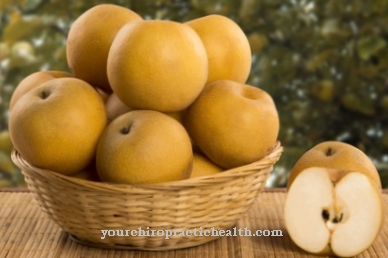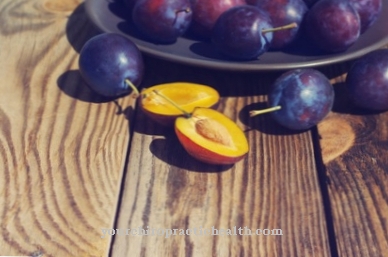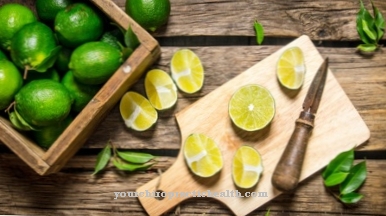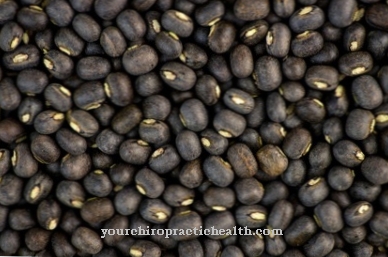Mangoes These are the names of the drupes of the tropical mango tree weighing up to 2 kg, whose yellowish flesh is valued for its sweet and sour taste.
Mangoes are now grown for commercial purposes almost worldwide in tropical and subtropical countries. In addition to the pulp, the flat, wide stones of the fruit are also used, from which a seed oil is obtained that is similar in its properties to cocoa butter and is also used in a similar way.
What you should know about the mango

Mangoes, the fruit of the mango tree, have been cultivated for more than 4,000 years. Its origin is believed to be in northern India and countries in Southeast Asia. In the Hindu Vedas dating from around 1200 BC Were written down in BC, mangoes are called the food of the gods.
Today mangoes are grown almost worldwide in tropical and subtropical countries. The largest producer of mangoes is still India, which accounts for around 15 million tons of annual production, 40 percent of the world's production of 37.9 million tons. In the growing countries there is usually a huge variety of different varieties on offer. They differ in size, shape, color and taste and texture of the pulp. However, only a few varieties are exported. The mangoes intended for export are picked and shipped in the so-called hard-ripe state, since fully ripe mangoes can only be kept for a short time and they are also fruits that ripen afterwards.
The harvest takes place throughout the year - as is often the case with tropical fruits - with a high season from April to July. The small but very sweet variety “Sensation” is cultivated on the Canary Islands. Their main harvest time falls in the months of October and November. The maturity of the mango does not correspond to the color of the skin, which can vary from green to orange to red or red-purple, but is given when the mango gives off its typical fruity scent and the small dent persists for a short time when the skin is pressed remains.
It is definitely advisable to give preference to organic quality when shopping in order to be sure that you can enjoy the pulp without any harmful substances. Because of the relatively short shelf life of mangoes, they are often processed into mango chutney or other products in the growing region. Mangoes are also offered as very tasty dried fruits in grocery stores.
Importance to health
The flesh of the mango can be eaten straight away, preferably raw. As a rule, this is not only extremely tasty, but also guarantees that the numerous ingredients with health relevance are available in their natural form.
The millennia-old use of the fruit for consumption has empirically ripened the knowledge that the consumption of mangoes normalizes digestion, at the same time stimulates the appetite and because of the high content of carotenoids, the precursor for vitamin A and some antioxidants, beneficial effects on the skin, mucous membranes and Has eyes. Some secondary ingredients influence the psyche in a positive way and prevent depressive moods. In addition, the mango is said to have positive effects on the quality of the man's sperm and on stimulating the sex hormones.
Certain ingredients in the mango show antiviral, antibacterial and antifungal effects. The health benefit of the mango for humans consists less in the properties of individual ingredients than in the overall effect of the individual substances in a kind of active compound, which helps the body metabolism to help itself and thus has a strengthening influence on the immune system.
Ingredients & nutritional values
The mango is valued primarily for its outstandingly sweet and slightly exotic taste, which is vaguely reminiscent of that of peaches, and for its versatility. The pulp, with its calorific value of around 60 kilocalories per 100 grams, is in the middle compared to other fruits.
The calorific value comes mainly from the 13 grams of carbohydrates that the pulp contains, because proteins and fats are only available in traces at 0.6 percent each. With regard to the primary ingredients, the mango can therefore be classified as relatively inconspicuous. What makes their special value are their secondary plant substances in the form of vitamins, enzymes, minerals and trace elements. Particularly noteworthy are their beta carotene content (1,160 µg / 100 g), which the body processes into vitamin A, and their extraordinary vitamin C content (35 mg / 100 g).
Various B vitamins are also available in physiologically usable quantities. Of the numerous minerals contained in the pulp of the mango, particular mention should be made of potassium, which is contained in a concentration of 150 to 190 milligrams per 100 grams of pulp.
Intolerances & allergies
The pulp of the mangoes is usually very well tolerated, so that the ingredients of the pulp rarely trigger allergic reactions or cause problems with histamine or fructose intolerance with the known symptoms.
However, allergies and intolerances occur more frequently in connection with substances that are in and on the shell. They are urushiole, aromatic glucosides that occur specifically in sumac, which also includes the mango tree. The urushiole in the mango peel are similar to those of other sumac plants such as the poison oak (poison ivy) and can trigger strong allergic reactions. This is mainly a problem in the mango growing areas for the people who z. B. come into constant contact with the mangoes during harvest.
The affected people often develop what is known as mango dermatitis. The problem is exacerbated when there is milk sap on the peel of the tree, which contains particularly high concentrations of urushiole.
Shopping & kitchen tips
It is definitely advisable to give preference to organic mangoes and to assess the degree of ripeness. Small and large black spots or dots on the skin indicate that it is fully ripe. The stronger smell of mango emanating is also an indication that it is ripe for consumption.
The fruit can then no longer be kept for a long time. If the peel cannot be easily pressed in, the mango is not yet ripe and can best ripen at room temperature. Ripening can be accelerated if the mangoes and apples are kept in a plastic bag at room temperature, but never below 10 degrees. Mangoes should not be stored in the refrigerator because they are sensitive to cold and lose their delicious aroma very quickly. The fruit should be washed and peeled neatly before consumption, as the peel contains toxic glucosides (urushiols), which are known to be strong allergens.
Preparation tips
Mangoes can be eaten pure because of their excellent taste, which is somewhat reminiscent of peach and pineapple. Mangoes, cut into small strips or cubes, go well with colorful salads or as an appetizer with raw ham. Mangoes are also very popular as an exotic fruit salad, along with pineapples, oranges and bananas. If necessary, the fruit salad can also be decorated with grated coconut. As a natural sweetener and flavoring agent, the pulp of the mango is also used in quark and yoghurt.













.jpg)

.jpg)
.jpg)











.jpg)